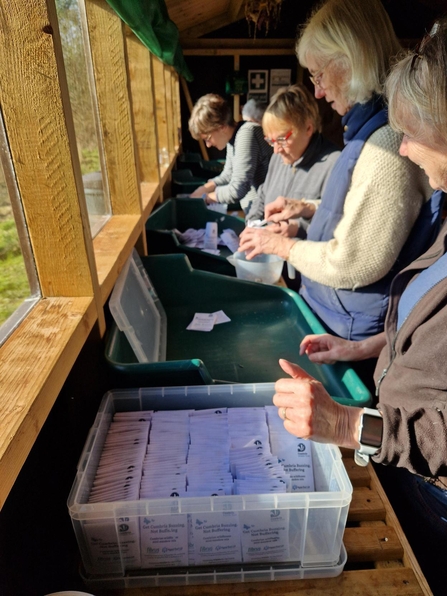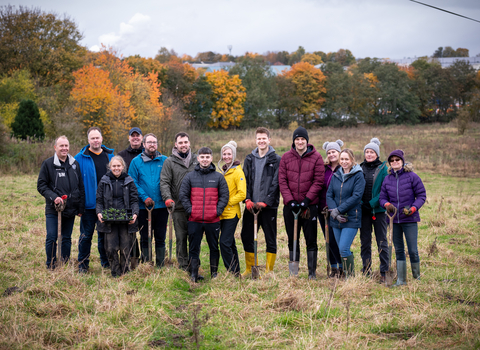'The importance of being in nature with regard to our mental wellbeing is widely recognised, but working in nature is a much deeper connection.'
Trust a wild life
Lynda (middle) making wildflower hanging baskets at Gosling Sike along with other volunteers.
I’ve volunteered with Cumbria Wildlife Trust since 2020. In that time I've learned lots about wildlife and nature, met some incredible, inspiring people and made lifelong friends. Being a volunteer means I experience the Trust’s reserves across the county, helping nature to recover and thrive.
I’ve always loved nature and the countryside, but until my volunteering journey began, this was very much as an observer and a visitor. For many years I lived in a green area of West London. Horsenden Hill is a large open space with woodlands, meadows, ponds, orchards and a farmhouse.
Owned by Ealing Council, the farm area and buildings had been largely neglected due to staff cutbacks. I was usually too busy working to appreciate this wonderful space.
Everything changed in 2015. I lost my only son suddenly and consequently I took early retirement. With so much nature on my doorstep I could spend my days walking the meadows trying to make sense of my life.
One day, while sitting by the pond watching Great Crested Newts, I met Jon, who introduced himself as the new ranger for the area. He told me about his vision for Horsenden - introducing livestock for conservation grazing – clearing overgrown areas – planting new woodlands and orchards – restoration of hedges and ditches and much more. I was intrigued! I was in!
Jon wanted to build a volunteer team and I offered to help. We became firm friends and developed a working partnership that continues to this day. We set up a Friends group that has since become a registered charity and now boasts around 80 regular volunteers.

Lynda and fellow volunteers at Gosling Sike planting seeds and transplanting seedlings in the potting shed
I immersed myself in this new life. We would hire a working horse to help with woodland management tasks, organised courses for traditional skills such as laying and maintaining hedgerows, scything, orchard management and organised community events such as Apple Days and Woodland Craft fairs and a Festival of Nature. Every day was a learning curve and a new adventure.
I’d always intended to move back to northern England. I love the wildness of the Pennines, so I headed to Brampton. This was during lock down and my days were spent walking and getting to know the landscape.
As soon as possible I looked for voluntary work, hoping to continue the path I had walked at Horsenden. Cumbria Wildlife Trust was recruiting volunteers for the Get Cumbria Buzzing! project at Gosling Sike. This was a great opportunity for me to contribute to the biodiversity of the landscape.
Get Cumbria Buzzing! created wildflower rich habitats across northwest Cumbria to help boost pollinators. The sites include roadside verges, farmland, community green spaces, orchards, church grounds, and public and private gardens. Around 300 hectares have been transformed. The initiative continues with the Planting for Pollinators project and the latest stage will see 15 wildlife havens created or restored by 2025.
My volunteering duties at Gosling Sike include planting seeds and transplanting seedlings in the potting shed. Our team works for two to three hours on a Wednesday morning. It’s very sociable, we enjoy each other’s company and have become firm friends.
It’s good to welcome new volunteers to get involved and, together with Gosling Sike staff, we help produce thousands of wildflower plug plants, destined for Trust project sites across Cumbria. In time they transform the landscape and attract butterflies and bees and other important pollinators.
We do find the wildflower names fascinating – they often have a story behind them, and this folklore is part of the charm. Herb-Robert, for instance, was once called ‘Saint Robert’s Herb’, after a French monk who used it to heal skin conditions and rubbing fresh leaves on your skin is believed to repel mosquitoes.

A conservation work day to remove sycamores that had self-seeded and if left, could threaten the native trees, such as the oaks.
I love to explore the Trust’s reserves and find that by volunteering I feel a sense of belonging. It’s a great privilege to visit sites that are hidden from public view too.
Here are a few volunteering roles I’ve enjoyed:
- Wreay Wood is a wonderfully diverse woodland reserve along the banks of the river Petteril. Here we carried out ‘Balsam bashing’; satisfying work as a quick tug on the stem removes this plant, roots and all. Removal is so important as this invasive species can wipe out native plants very quickly. Although it is a pretty plant and bees love it, many riverside walks have seen balsam take over completely.
- Quarry Bank is a small reserve with remnants of an ancient woodland. I joined a conservation task day working party to remove sycamores that had self-seeded and if left, could threaten the native trees, such as the oaks. We were there a few days after the felling of the sycamore at Sycamore Gap on Hadrian’s Wall, so it felt very strange that we were uprooting sycamores when the country was in mourning for the iconic specimen that was felled. However, they had to be removed or they would end up dominating the native oaks and that would be a tragedy too.
- A group of us represented Cumbria Wildlife Trust at the RHS Tatton Flower Show, supporting Trustee Danny Poland. Danny created his "gardening for wildlife" entry for the RHS Tatton Park Show after receiving an award from Cumbria in Bloom. The small garden - which measured just 3m sq – is now replanted in the heart of Irthington where Danny inspires others to garden for wildlife.
My favourite volunteer role has to be White Face Darter Monitoring. This wonderful dragonfly has suffered a decline in the last 40 years as 90% of lowland peat bog in Britain has been lost due to excessive cultivation and pollution.
They require acidic pools with Sphagnum moss at the edges in which to lay their eggs, and scrubland away from the peat bog in which to roost. They were introduced to Drumburgh nature reserve in 2019 and the site we monitor is a few miles away.
For two years I’ve joined a working party that treks across a hidden landscape, no public access and very boggy – sometimes knee deep. There we count the exuvia - the skins the darter nymphs emerge from to assess how the introduced population is faring.
All the volunteer roles I’ve described here are led by an experienced Trust staff member. They are all encouraging, helpful and knowledgeable and ensure our experience is the best it can be, keeping us safe and adding to our enjoyment.
I realise I’ve included some very personal details here, but I want to make an important point. The importance of being in nature with regard to our mental wellbeing is widely recognised, but working in nature is a much deeper connection. We get muddy and dirty and very close to nature. This level of connection does so much more for our wellbeing than simply being outside in nature as an observer or a visitor.
When I lie by the edge of a pond, searching for the gossamer thin shells of the darters, my face millimetres away from the Spaghnum moss and creatures of the pond, I feel this connection most strongly and feel alive in the natural world.


